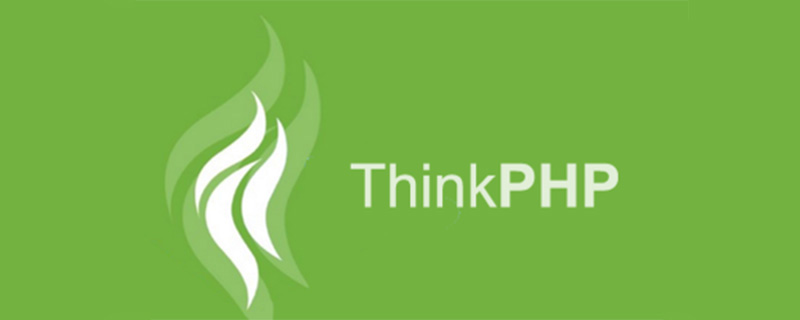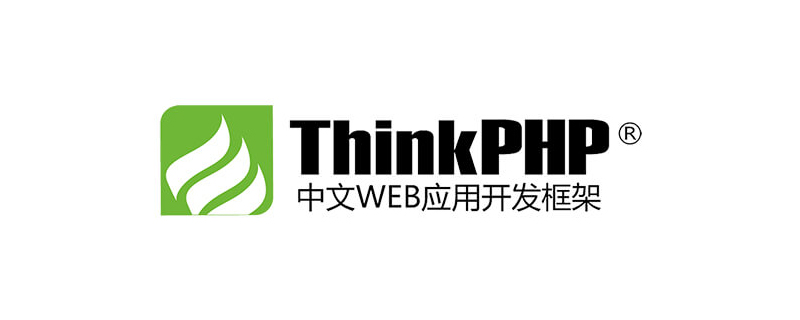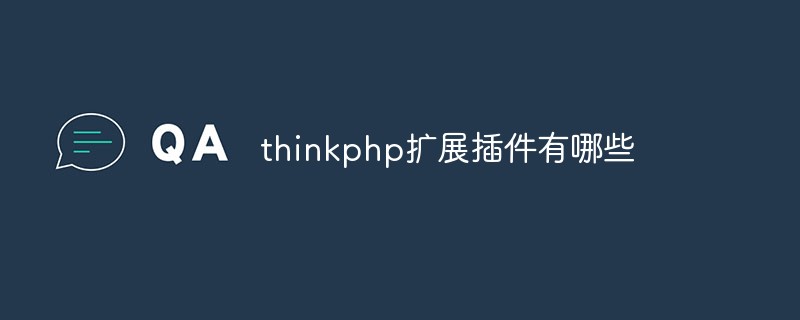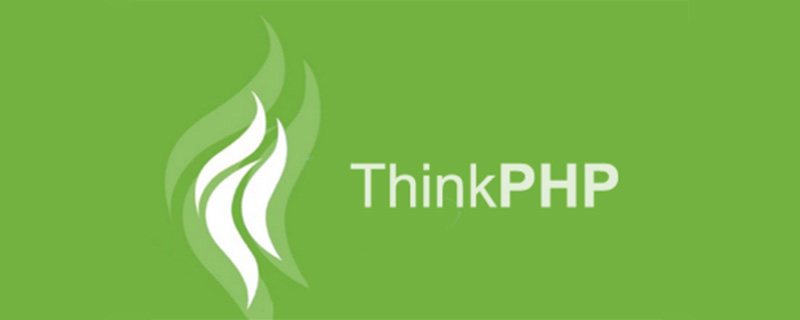In the current field of web application development, many enterprise-level web applications are implemented using the PHP language. Among them, the ThinkPHP framework is one of the pioneers in the development of domestic PHP frameworks. After years of development and improvement, it has become one of the most popular PHP frameworks in China. This article will build a complete enterprise-level Web application from scratch through the learning and practice of the ThinkPHP6 framework.
1. Installation and configuration
First, we need to install PHP and database (MySQL or other), as well as composer package manager in the local environment.
Secondly, download the latest version of the ThinkPHP6 framework and place the file in the specified working directory. Next, execute the "composer install" command in the command line window to install the dependent libraries and plug-ins required by the framework.
Then, we need to configure the project. First, configure the project's environment variables into the .env file, and rename the .env.example file to the .env file. Secondly, configure the database and set the database connection information in the /config/database.php file.
Finally, we need to run the "php think migrate:run" command in the root directory to create the database table and initial data.
2. Create controller and model
In the ThinkPHP6 framework, the controller (Controller) is used to process HTTP requests, and the main business logic processing is handled by the controller. Model is a class that obtains or stores data by operating the database.
In this example, we create a User controller and corresponding User model. Create the User.php file in the /app/controller folder and write the following code:
<?php
namespace appcontroller;
use think
acadeDb;
use think
acadeRequest;
class User
{
public function getAllUser()
{
$userList = Db::table('user')->select();
return json_encode($userList);
}
public function getUserById($id)
{
$user = Db::table('user')->where('id', $id)->find();
return json_encode($user);
}
public function addUser()
{
$data = Request::param();
Db::table('user')->insert($data);
return 'Add Successfully';
}
public function updateUser($id)
{
$data = Request::param();
Db::table('user')->where('id', $id)->update($data);
return 'Update Successfully';
}
public function deleteUser($id)
{
Db::table('user')->where('id', $id)->delete();
return 'Delete Successfully';
}
}Create the User.php file in the /app/model folder and write the following code:
<?php
namespace appmodel;
use thinkModel;
class User extends Model
{
protected $table = 'user';
}3. Create routing and views
In the ThinkPHP6 framework, routing (Route) is used to map URLs to corresponding controllers and methods, and view (View) is used to present the controller after processing. Data after business logic.
In this example, we created the following routes:
- GET /user: Get a list of all users and use the getAllUser method to process it.
- GET /user/:id: Get user information based on user ID, use getUserById method to process.
- POST /user: Add a new user, use the addUser method to process.
- PUT /user/:id: Update user information based on user ID, use updateUser method to process.
- DELETE /user/:id: Delete a user based on the user ID and use the deleteUser method.
In the /app/route.php file, write the following code:
<?php
use think
acadeRoute;
Route::get('/user', 'User/getAllUser');
Route::get('/user/:id', 'User/getUserById');
Route::post('/user', 'User/addUser');
Route::put('/user/:id', 'User/updateUser');
Route::delete('/user/:id', 'User/deleteUser');Next, create a User folder under the /app/view folder and place it in the folder Create view files such as index.html, edit.html, add.html and so on.
In the index.html file, we can list all user lists. In the edit.html and add.html files, we can edit and add user information.
Finally, write the corresponding view rendering method in the controller. For example, in the User controller, we can write the following code:
public function all()
{
return view('index')->assign('userList', Db::table('user')->select());
}
public function edit($id)
{
return view('edit')->assign('user', Db::table('user')->where('id', $id)->find());
}
public function add()
{
return view('add');
}4. Implement user authentication
In enterprise-level Web applications, user authentication is a very important function. Within the ThinkPHP6 framework, we can implement simple and flexible user authentication through the Auth component.
First, we need to perform authentication-related configurations in the /config/auth.php file.
Next, we can use the login, logout, check and other methods provided by the Auth component in the controller to develop the user authentication function. For example, in the User controller, we can write the following code:
<?php
namespace appcontroller;
use appmodelUser as UserModel;
use think
acadeDb;
use think
acadeRequest;
use think
acadeSession;
use think
acadeView;
use thinkuthAuth;
class User
{
public function login()
{
if (Request::isPost()) {
$data = Request::param();
if (Auth::attempt(['username' => $data['username'], 'password' => $data['password']])) {
Session::flash('success', 'Login successfully.');
return redirect('/index');
} else {
Session::flash('error', 'Login failed.');
return view('login');
}
} else {
return view('login');
}
}
public function register()
{
if (Request::isPost()) {
$data = Request::param();
$userModel = new UserModel();
$userModel->save($data);
return redirect('/login');
} else {
return view('register');
}
}
public function logout()
{
Auth::logout();
Session::flash('success', 'Logout successfully.');
return redirect('/login');
}
public function check()
{
$user = Auth::user();
if (!$user) {
Session::flash('error', 'You are not logged in.');
return redirect('/login');
}
return $user;
}
}5. Implement the API interface
In enterprise-level web applications, the API interface is a very important function. Within the ThinkPHP6 framework, we can develop API interfaces to meet the data requests from the calling end.
In this example, we created the following API interfaces:
- GET /api/user: Get a list of all users, use the getAllUser method to process.
- GET /api/user/:id: Get user information based on user ID, use getUserById method to process.
- POST /api/user: Add a new user, use the addUser method to process.
- PUT /api/user/:id: Update user information based on user ID, use updateUser method to process.
- DELETE /api/user/:id: Delete a user based on the user ID and use the deleteUser method.
In the controller, we need to handle the API interface version, request type, request parameters, response format and other related content.
For example, in the User controller, we can write the following code:
<?php
namespace appcontroller;
use appmodelUser as UserModel;
use think
acadeDb;
use think
acadeRequest;
class User
{
// ...
public function getAllUser()
{
$userList = Db::table('user')->select();
return json($userList);
}
public function getUserById($id)
{
$user = Db::table('user')->where('id', $id)->find();
return json($user);
}
public function addUser()
{
$data = Request::param();
Db::table('user')->insert($data);
return 'Add Successfully';
}
public function updateUser($id)
{
$data = Request::param();
Db::table('user')->where('id', $id)->update($data);
return 'Update Successfully';
}
public function deleteUser($id)
{
Db::table('user')->where('id', $id)->delete();
return 'Delete Successfully';
}
}6. Deploy Web applications
After we develop the enterprise-level Web application, we need Deploy it to the server for users to access. During the specific deployment process, we need to pay attention to the following points:
- Security: During the deployment process, we need to ensure the security of the application. For example, application security is ensured by encrypting sensitive data and filtering out malicious requests.
- Performance optimization: During the deployment process, we need to perform performance optimization on the application. For example, use caching technology to speed up page access, enable Gzip compression to reduce the amount of data transmission, etc. to improve application performance.
- Monitoring and maintenance: During the deployment process, we need to establish a complete monitoring and maintenance system. For example, use an independent log server to store log information, use monitoring tools to monitor the running status of the application in real time, etc. to ensure the effective operation of the application.
4. Summary
Through the above steps, we successfully used the ThinkPHP6 framework to create a complete enterprise-level Web application from scratch, and learned the corresponding knowledge and Skill. In future development work, we can flexibly use these technologies according to specific situations to develop better Web applications.
The above is the detailed content of Create a complete enterprise-level web application through ThinkPHP6. For more information, please follow other related articles on the PHP Chinese website!
 thinkphp是不是国产框架Sep 26, 2022 pm 05:11 PM
thinkphp是不是国产框架Sep 26, 2022 pm 05:11 PMthinkphp是国产框架。ThinkPHP是一个快速、兼容而且简单的轻量级国产PHP开发框架,是为了简化企业级应用开发和敏捷WEB应用开发而诞生的。ThinkPHP从诞生以来一直秉承简洁实用的设计原则,在保持出色的性能和至简的代码的同时,也注重易用性。
 一起聊聊thinkphp6使用think-queue实现普通队列和延迟队列Apr 20, 2022 pm 01:07 PM
一起聊聊thinkphp6使用think-queue实现普通队列和延迟队列Apr 20, 2022 pm 01:07 PM本篇文章给大家带来了关于thinkphp的相关知识,其中主要介绍了关于使用think-queue来实现普通队列和延迟队列的相关内容,think-queue是thinkphp官方提供的一个消息队列服务,下面一起来看一下,希望对大家有帮助。
 thinkphp的mvc分别指什么Jun 21, 2022 am 11:11 AM
thinkphp的mvc分别指什么Jun 21, 2022 am 11:11 AMthinkphp基于的mvc分别是指:1、m是model的缩写,表示模型,用于数据处理;2、v是view的缩写,表示视图,由View类和模板文件组成;3、c是controller的缩写,表示控制器,用于逻辑处理。mvc设计模式是一种编程思想,是一种将应用程序的逻辑层和表现层进行分离的方法。
 thinkphp扩展插件有哪些Jun 13, 2022 pm 05:45 PM
thinkphp扩展插件有哪些Jun 13, 2022 pm 05:45 PMthinkphp扩展有:1、think-migration,是一种数据库迁移工具;2、think-orm,是一种ORM类库扩展;3、think-oracle,是一种Oracle驱动扩展;4、think-mongo,一种MongoDb扩展;5、think-soar,一种SQL语句优化扩展;6、porter,一种数据库管理工具;7、tp-jwt-auth,一个jwt身份验证扩展包。
 实例详解thinkphp6使用jwt认证Jun 24, 2022 pm 12:57 PM
实例详解thinkphp6使用jwt认证Jun 24, 2022 pm 12:57 PM本篇文章给大家带来了关于thinkphp的相关知识,其中主要介绍了使用jwt认证的问题,下面一起来看一下,希望对大家有帮助。
 一文教你ThinkPHP使用think-queue实现redis消息队列Jun 28, 2022 pm 03:33 PM
一文教你ThinkPHP使用think-queue实现redis消息队列Jun 28, 2022 pm 03:33 PM本篇文章给大家带来了关于ThinkPHP的相关知识,其中主要整理了使用think-queue实现redis消息队列的相关问题,下面一起来看一下,希望对大家有帮助。
 thinkphp 怎么查询库是否存在Dec 05, 2022 am 09:40 AM
thinkphp 怎么查询库是否存在Dec 05, 2022 am 09:40 AMthinkphp查询库是否存在的方法:1、打开相应的tp文件;2、通过“ $isTable=db()->query('SHOW TABLES LIKE '."'".$data['table_name']."'");if($isTable){...}else{...}”方式验证表是否存在即可。
 thinkphp3.2怎么关闭调试模式Apr 25, 2022 am 10:13 AM
thinkphp3.2怎么关闭调试模式Apr 25, 2022 am 10:13 AM在thinkphp3.2中,可以利用define关闭调试模式,该标签用于变量和常量的定义,将入口文件中定义调试模式设为FALSE即可,语法为“define('APP_DEBUG', false);”;开启调试模式将参数值设置为true即可。


Hot AI Tools

Undresser.AI Undress
AI-powered app for creating realistic nude photos

AI Clothes Remover
Online AI tool for removing clothes from photos.

Undress AI Tool
Undress images for free

Clothoff.io
AI clothes remover

AI Hentai Generator
Generate AI Hentai for free.

Hot Article

Hot Tools

ZendStudio 13.5.1 Mac
Powerful PHP integrated development environment

mPDF
mPDF is a PHP library that can generate PDF files from UTF-8 encoded HTML. The original author, Ian Back, wrote mPDF to output PDF files "on the fly" from his website and handle different languages. It is slower than original scripts like HTML2FPDF and produces larger files when using Unicode fonts, but supports CSS styles etc. and has a lot of enhancements. Supports almost all languages, including RTL (Arabic and Hebrew) and CJK (Chinese, Japanese and Korean). Supports nested block-level elements (such as P, DIV),

SecLists
SecLists is the ultimate security tester's companion. It is a collection of various types of lists that are frequently used during security assessments, all in one place. SecLists helps make security testing more efficient and productive by conveniently providing all the lists a security tester might need. List types include usernames, passwords, URLs, fuzzing payloads, sensitive data patterns, web shells, and more. The tester can simply pull this repository onto a new test machine and he will have access to every type of list he needs.

WebStorm Mac version
Useful JavaScript development tools

DVWA
Damn Vulnerable Web App (DVWA) is a PHP/MySQL web application that is very vulnerable. Its main goals are to be an aid for security professionals to test their skills and tools in a legal environment, to help web developers better understand the process of securing web applications, and to help teachers/students teach/learn in a classroom environment Web application security. The goal of DVWA is to practice some of the most common web vulnerabilities through a simple and straightforward interface, with varying degrees of difficulty. Please note that this software






